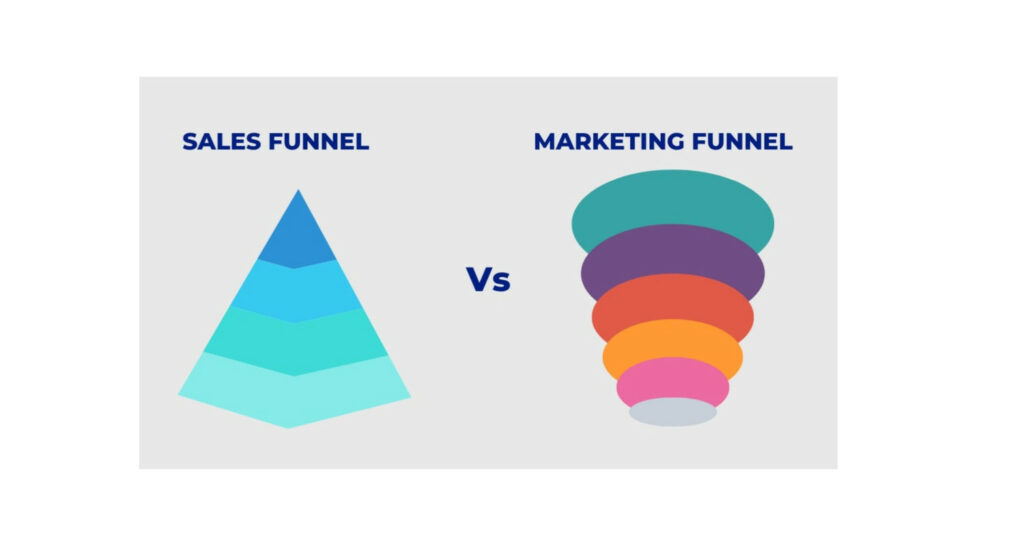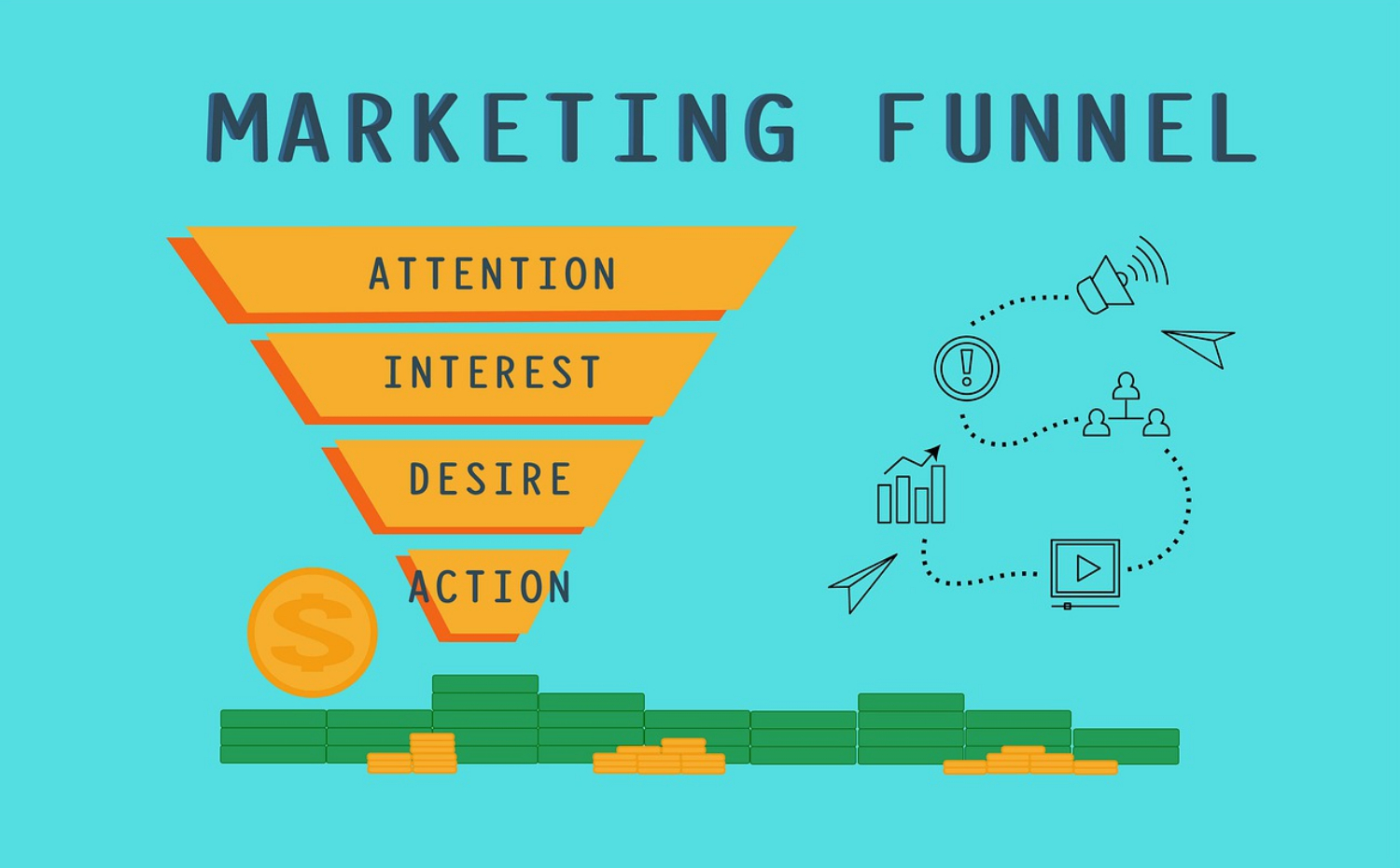In this article, we’ll discuss the differences between two funnels i.e. Sales funnel vs Marketing funnel. Marketing is a necessary business activity that helps companies get publicity and gain a competitive edge. The marketing funnel often focuses on introducing a brand to a wide range of people. Its purpose is to attract prospects who can quickly convert into consumers.
When candidates are found and are curious about the item or service, they are routed via the sales funnel. At this time, the prospect has evolved into a sales prospect. The sales funnel is the method that moves a potential client from the conquest stage (marketing) to the conversion stage. The funnel was filled in at the narrowest part of the marketing funnel’s cone form.
Here we are showing the broad difference between a sales funnel and a marketing funnel, which includes similar definitions and almost everything needed to know about them.
A funnel for sales is a marketing phrase that describes and captures the route potential consumers take from prospecting to purchasing. A funnel for sales is a combination of many procedures, all of which vary based on each organization’s sales strategy. Some people keep their model basic, employing the “TOFU-MOFU-BOFU“ technique, which involves the funnel’s top, middle, and bottom as discrete pieces.
Sales Funnel vs. Marketing Funnel
Let’s start with the Sales Funnel first-
Sales Funnel
What are the stages of the sales funnel?
Awareness
The sales funnel’s first step occurs when someone becomes aware of your good or service.
When someone sees your advertisement, learns about your business on social media, or gets comments from relatives or close friends via word-of-mouth advertising, they may become aware.
A prospect may also find your company through searches on Google or your company blog.
Interest
Your prospect knows your organization, brand, and goods or services.
They’ve opted to assess it depending on their degree of curiosity.
At this point, it’s critical to employ an approach to content by generating high-quality material that provides information to prospects without blatantly selling to them.
Decision
The consumer is poised for purchase and may examine various possibilities before deciding.
They will examine cost, bundles, and other aspects to choose the best solution.
When customers order, you could give free delivery, a price reduction code, a digital discount code, or a bonus product.
The idea is to achieve an enticing offer so the prospect will proceed and select your request.
Action.
For example, congratulate the consumer for their purchase, request comments, give post-purchase help, invite them to join your newsletter, or register them in an end-user loyalty program for incentives.
Market funnel
What are the market funnel stages?
Awareness
The prospective consumer is at the awareness stage when they become mindful that a seller offers something,
a solution or a resource that will fulfill their demands.
It can occur via advertising, word of mouth, prospective investigation, or other avenues.
After becoming conscious, the prospect will evaluate how they might locate a suitable solution to their difficulty.
When a prospect indicates that they are interested in an item or service,
consumers go through an assessment process to seek additional details,
evaluate the offerings of multiple rivals, and become more knowledgeable about the product’s variables.
At this stage, the salesperson must make a persuasive case for the efficiency of their product to the prospect.
Desired
Getting an applicant to make a choice boils down to providing them with all of the information they require,
addressing any concerns that are preventing them from acting, assuaging any worries that they may have,
and showing them why the action they are about to take will result in fulfillment.
This is the point at which the salesman must exhibit his authority and convince the buyer that his product is the best alternative.
Action
The potential consumer accomplishes this procedure by becoming an active customer.
As a second phase of the active component, it is possible to convert one-time consumers into recurring clients.
By offering the consumer precisely what they want and additional information, businesses can keep them returning while raising awareness and drawing prospective customers within the sales funnel.
Sales Funnel vs. Marketing Funnel – Main Difference
A narrow line occurs between the marketing funnel and the sales funnel.
In truth, both phrases are used collectively, and distinguishing them is difficult.
The only significant difference between these names is the context in which they are used.
Marketing, as well as sales operations are sometimes two separate positions.
Each has a road map that specifies the growth of a prospective consumer.
Because marketing produces passion, your bottom of the funnel for advertising correlates to the top of the revenue funnel.
As a result, advertising campaigns that increase product awareness and demand drive the sales funnel.
However, many businesses combine both activities, making it more challenging to differentiate between a sales-supporting advertising plan and an advertising approach.
Furthermore, corporations create bespoke stages for each funnel to streamline their procedures.
As a result, the line between the sales and marketing funnels has blurred.
Comparison between the Sales Funnel and the Market Funnel
A sales funnel is a method that directs a potential customer from the marketing phase to the conversion stage.
The marketing funnel, on the other hand, relates to the process of turning a lead or prospective consumer into a customer.
Focus
While the revenue funnel is concerned with increasing product or service sales, the advertising funnel is concerned with brand awareness and image.
While the revenue funnel retains customer interest, the advertising funnel generates consumer interest.
Sales and marketing funnels have similarities.
Both assist firms in visualizing their consumers’ journeys.
They strive to increase sales through brand or product recognition.
Sale and market funnel parties acquire techniques, procedures, strategies, and instruments to optimize each level.
FAQs
What exactly is a funnel within sales and marketing?
Marketing funnels describe paths to acquisition and beyond, from the first phases when an individual learns about your organization through the purchase stage
What are the two kinds of marketing funnels?
Although marketing funnels is a more powerful word that encompasses various use cases, you are likely to encounter numerous sorts of funnels: Conversion funnels for lead magnets, Conversion funnels for list development.
What is the distinction between a business-to-business marketing funnel and a business-to-business sales funnel?
A business-to-business advertising funnel aims to create touchpoints and give customers a reason to buy. A business-to-business transaction funnel is more proactive, emphasizing the steps that must be taken at each stage of the customer journey to turn a prospect into a client successfully.
What constitutes a sales funnel, and what are some examples?
A sales funnel, referred to as a buy funnel, is a graphical depiction of a client's journey that depicts the selling process from consciousness to action.
Conclusion
In conclusion, the difference between the two i.e. sales funnel vs marketing funnel, is a complex issue that could be debated all day.
However, marketing and sales are similar in many respects.
See also, SumUp vs. Square: Pick the Right One for Your Business
For example, both endeavors deal with psychology, cost funds, and intend to make money.
A marketing funnel promotes a good or service to persuade leads to purchase it.
On the other hand, the sales funnel works with prospects (from the marketing funnel), persuading them to buy as frequently as feasible.



